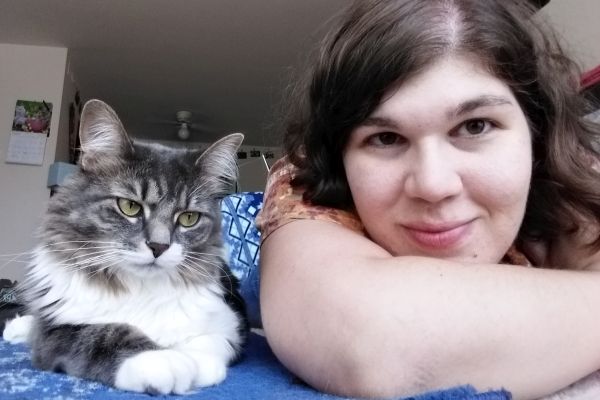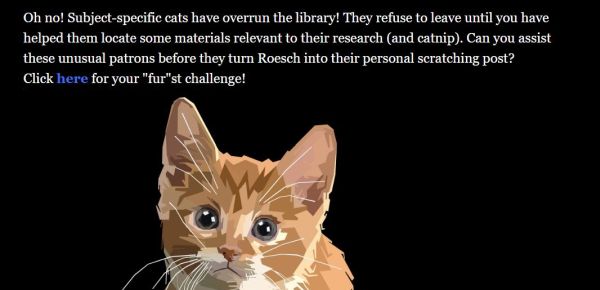University Libraries

Library Training Module is the ‘Cat’s Pajamas’
By Maureen Schlangen
The training of students for the Knowledge Hub research desk has taken a fluffy, adorable and technological turn.
Using an open-source interactive media program called Twine, Roesch Library research services assistant Jillian Sandy harnessed the irresistible appeal of internet cats to create “Searching UD CATalog: A Roesch Library Adventure.”
Designed to build fluency in Library of Congress classification, the adventure begins with a challenge: “Subject-specific cats have overrun the library! They refuse to leave until you have helped them locate some materials relevant to their research (and catnip). Can you assist these unusual patrons before they turn Roesch into their personal scratching post?”
The questions start out easy and grow more advanced as the story continues; most players will of course want 100 percent, but a wrong answer’s response is a worthy trade-off:
"No, human! Now face my wrath!" You narrowly escape a swipe from claws sharpened by years of scratching mid-priced home furniture. Try again.
Though she created it for library student employees, anyone is welcome to try it. When users are done, they even get a “purr-tificate” of completion.
Developing students: a sound strategy
This is not Sandy’s fur-st foray into technology to make library skills training as fun as it is effective — but it’s definitely the most awwww-inspiring. Before “CATalog,” she created a Knowledge Hub student employee site on Isidore, UD’s learning management system; built an online research desk reference tool using a platform called LibGuides; and used Google Forms to create exercises to sharpen catalog searching skills.
The training programs help fulfill a commitment in the Libraries’ strategic plan to creating structured, dynamic professional development and leadership training for student employees. The idea is to not only provide excellent service, but also elevate student employees’ practical knowledge for their long-term professional and academic pursuits.
Sandy’s personal strategy: Create an interesting learning experience, and whenever possible, use cat puns.
“After I ran out, the internet did help me a lot,” Sandy says. “People on the internet seem to like cats.”
A lifelong love
Clearly, so does Sandy, whose Twine username is JSandcat. It all started with a feral kitten her family took in when she was 7.
“He was adorable but so mean,” Sandy says. “He chased one of my friends around our house during a sleepover. I love how we can see very human traits in cats — their grumpiness, impatience and overall weirdness — yet we’re OK with their behavior because it’s all wrapped up in a soft, fuzzy, little body.”
To this day, cuteness cancels out cats’ cantankerousness.
“My cat is named Bertha Mason,” Sandy says. “Like her namesake*, she is wild and badly behaved by societal standards. However, she does have a remarkably fluffy tail and some cute moments when she meows at me until I sit down to serve as a human pillow.”
As library training modules go, “CATalog” seems like it would be hard to top — but not im-paws-ible, she says: “An all-dog or unicorn version has been suggested.”
Colloquial clarity
cat’s pajamas: n. [Colloq.] outstanding; a variation on cat’s meow.
Mason, Bertha: fictional character in Charlotte Bronte’s Jane Eyre. The mentally ill first wife of Mr. Rochester, she was quarantined in the attic of Thornfield Hall.

